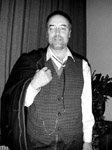
On September 28th, 2002 I had the chance to attend a conference hosted by the Swiss Watch Collectors Association ‚Chronometrophilia', held in Bern. Among the attendants were Thomas Prescher, a skillful master watchmaker (more in the tourbillon section at the end of this report) and Bernhard Zwinz, also master watchmaker who works with ‚Mr. Simplicite' Philippe Dufour. Several Talks were given on electric and wooden clocks, tourbillons and, this especially caught my attention, on ‚Ethic and Philosophy of the restauration of watches'. The latter one was given by Dr. Ludwig Oechslin, former creative head of Ulysse-Nardin and now director of the ‚International Watch Museum' in La-Chaux-de-Fonds.
I took the freedom to report here a summary of his talk as well as to present three impressive pocket watch tourbillons a tourbillon collector and a innovative watchmaker brought along (at the end of the report). Please note that Dr. Oechslin gave his talk in German. Since English is not my native tongue please be indulgent with any mistake I eventually made. And please excuse also the pics I took, I was sitting directly next to Dr. Oechslin in a small and over-crowded room, therefore the viewing angle was not the best, and I could not move in the room. Enough for the fore-word, here we go:

(i) What
is a historically valuable object?
Any object can be defined to be of historical value because of his
A. material
B. form and appearance
C. function
Here, physical, aesthetical and functional aspects merge into a historical object that either tells a certain story or bears witness to something. Since all objects are prone to abrasion, wear or degradation, humankind has the duty to conserve them for future generations. So the first question to answer is: What to conserve?
(ii) Restauration or Conservation?
This is the second important decision to make: Back up the current condition
(conservation) or bring back the original status (restauration)?
This question is more important that it seems on the first view. Fact is, that any alterations are normally not reversible. Oechslin gave some guidelines for a decision of what to do: Is the object meant to tell history (conservation) or is he meant to testify a specific historical time (restauration)? What are the adequate measures to achive the selected aim? What is the relationship of the object with respect to all the other artifacts of the collection? What are the means of communication of the collection (watches: running or not, in show cases, video presentations, internet?)? Oechslin believes that an integrated theory, consisting of research and communication, has to be set up for each individual case since there is no generally admitted answer. Also, any decision reflects the morale of a society and a single person.
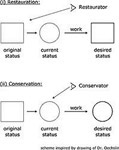
The decision to restaurate or to conservate of course has its consequences for the work to do. For example, a prized pocket watch is the object of a comming restauration or conservation. The restaurator wants of course to restore the function of the clockwork. Therfore he will certainly exchange defective parts or make even new ones from scratch. Afterwards the watch will tell about the function. The conservator wants to keep the watch in its current state. He ‚just' wants to stop or slow down the destruction process. He would not exchange any parts, but will keep the patina. Most likely the watch will not work afterwards, but it will tell the story of her history. In any case, some aspects will be excluded: In the first one history, in the latter one the function. This is the reason why any owner of such an object has the ethical duty to make a well founded decision.
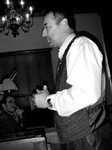
(iv) Exemplary tourbillons
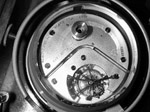
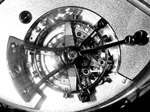
Then, to stay with Ulysse-Nardin, a UN marine chronometer with tourbillon avec remontoir d'egalite, achieved with 2 escapements within (!) the tourbillon cage, which you can see on the left part of the enlarged pic:
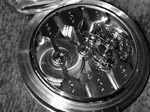
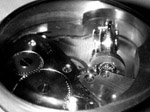 |
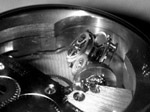 |
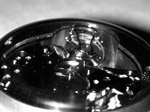 |
Mr. Prescher
worked together with no one else than Mr. Richard Daners whom some of
you might know. Daners is the maker of the angled tourbillons, inspired
by the work or Walter Prendel. You can read more on Prendel's work here.
I'm very fascinated by this masterpiece and I'm happy that Mr. Prescher
invited me to his workshop to give me the opportunity to write a report.
I think we all can look forward to another exciting rising star on the
watchmaking sky!
